模块1 Unit 1 Friendship grammer
文档属性
| 名称 | 模块1 Unit 1 Friendship grammer |  | |
| 格式 | rar | ||
| 文件大小 | 858.4KB | ||
| 资源类型 | 教案 | ||
| 版本资源 | 人教版(新课程标准) | ||
| 科目 | 英语 | ||
| 更新时间 | 2011-11-18 14:32:15 | ||
图片预览


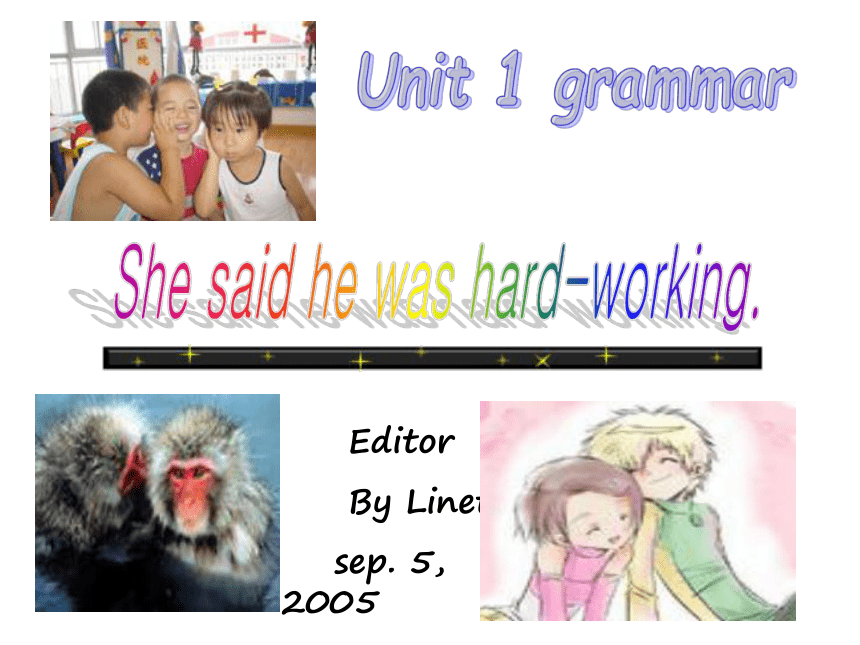

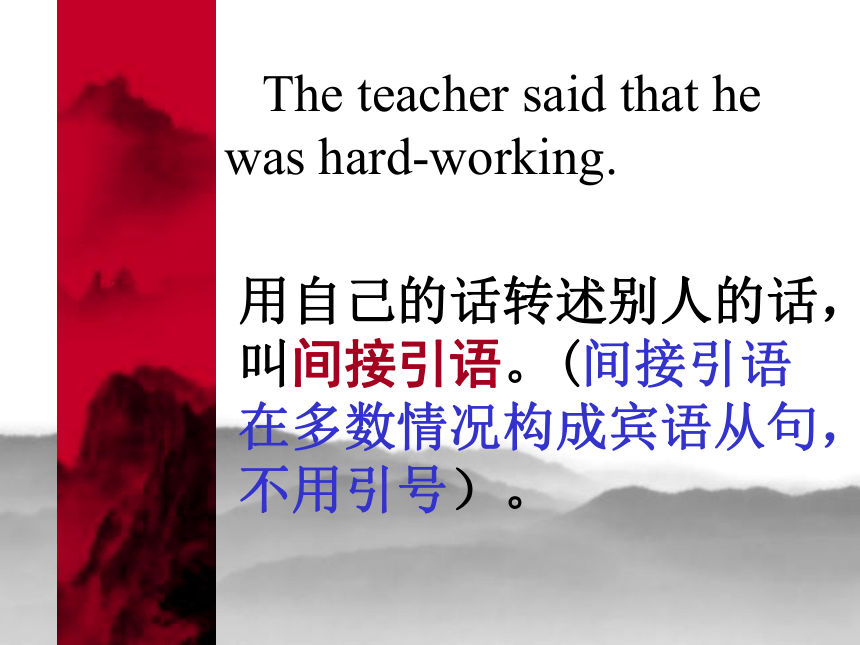
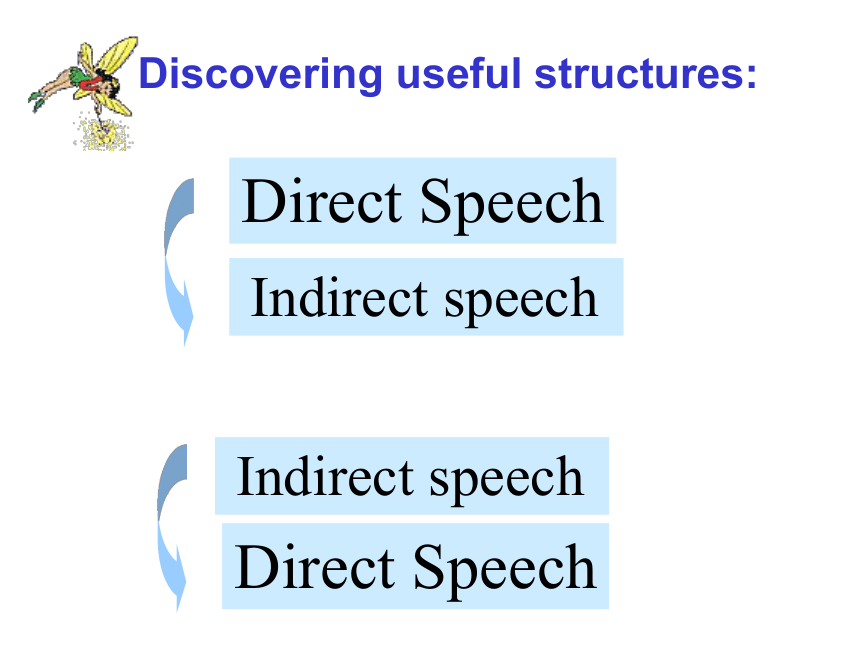
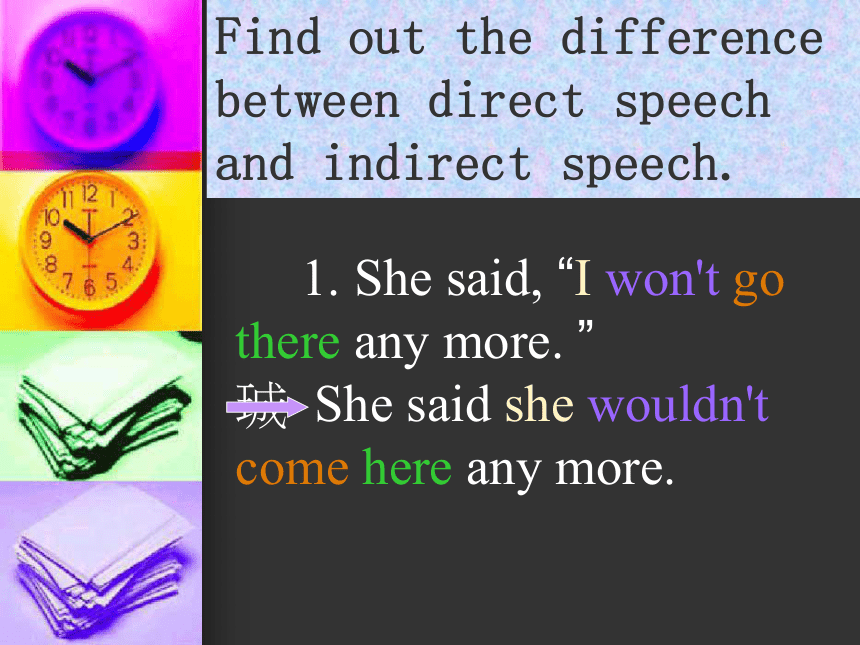
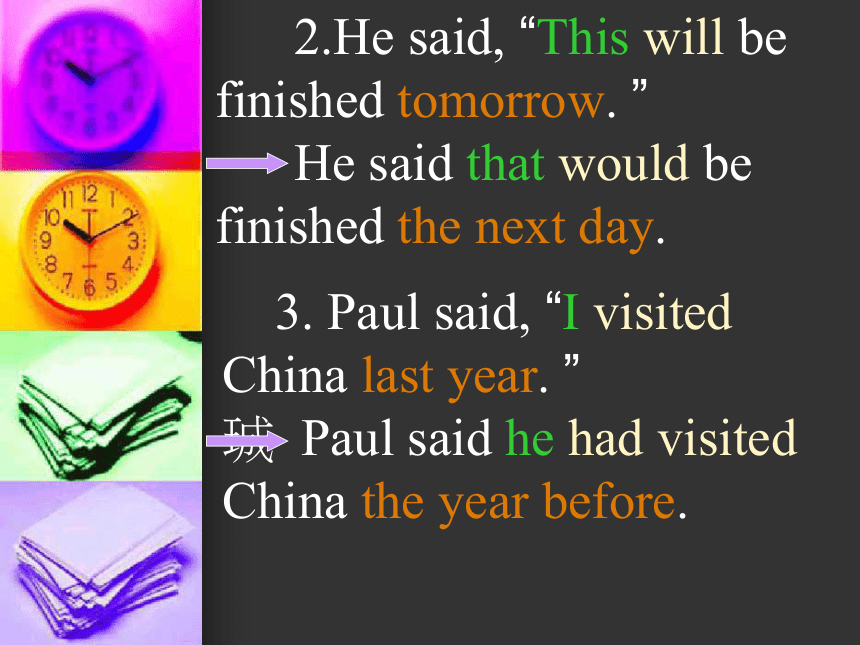
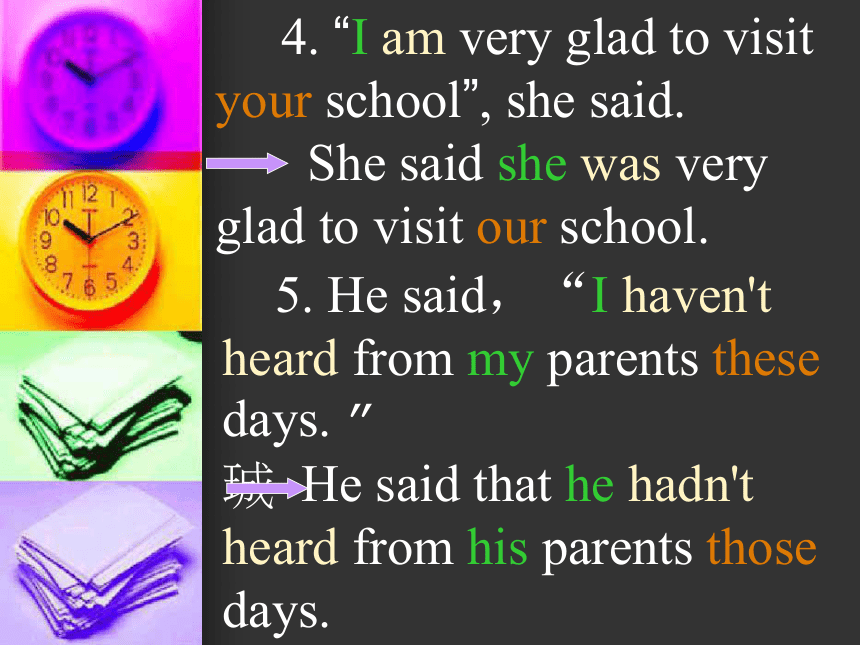
文档简介
(共23张PPT)
Editor
By Linette
sep. 5, 2005
直接引述别人的原话,叫直接引语。(直接引语一般 前后要加引号 )
The teacher said, “he is hard-working.”
用自己的话转述别人的话,叫间接引语。(间接引语在多数情况构成宾语从句,不用引号)。
The teacher said that he was hard-working.
Indirect speech
Direct Speech
Indirect speech
Direct Speech
Discovering useful structures:
1. She said, “I won't go there any more. ”
? She said she wouldn't come here any more.
Find out the difference between direct speech and indirect speech.
2.He said, “This will be finished tomorrow. ”
He said that would be finished the next day.
3. Paul said, “I visited China last year. ”
? Paul said he had visited China the year before.
4. “I am very glad to visit your school”, she said.
She said she was very glad to visit our school.
5. He said,“I haven't heard from my parents these days. ”
? He said that he hadn't heard from his parents those days.
一.陈述句(Statements)
直接引语如果是陈述句,变为间接引语时,用连词that引导。从句的人、时态、指示代词、时间状语、地点状语等要作相应的变化。
1)人称的变化
他说:“我非常喜欢它。”
他说他非常喜欢它。
2)时态的变化
如主句的谓语动词是一般过去时,直接引语变间接引语时,从句的谓语动词在时态上要作相应的变化。如主句的谓语动词是现在时,从句的时态则无需变化。
He said, “I like it very much.”
He said that he liked it very much.
直接引语转换为间接引语时人称代词转换规律
He said to Tom,“I can help them.”
He said to Tom that he could help them.
He said to her,“You can help them.”
He told her that she could help them.
He said to Tom,“They can help them.”
He told Tom that they could help them.
一从主:
二从宾:
三不变:
3)指示代词、时间状语、地点状语和动词的变化
间接引语
直接引语
She said that she would go there that evening.
She said, “I’ll come here this evening.”
Come-go
He said that his sister had been there one week before.
He said, “My sister was here one week ago.”
Here-there
She told me that he had left 30 minutes before.
She said, “He leftt 30 minutes ago.”
Ago- before
She said that she would go there the next day.
She said, “I’ll go there tomorrow.”
Tomorrow-the next day
She said that she had gone there the day before.
She said, “I went there yesterday.”
Yesterday-the day before
HE said that he hadn’t seen her that day.
He said, “I haven’t seen her today.”
Today-that day
He said that it was nine o’clock then.
He said, “It’s nine o’clock now.”
Now-then
He said that those books were his.
He said, “These books are mine.”
These-those
She said that she would finish the work that morning.
She said, “I’ll finish the work this morning.”
This-that
例 句
直接引语转化间接引语时的变化
时态的变化
间接引语
直接引语
She said that she would do it after class.
She said, “I’ll do it after class.”
一般将来时- 过去将来时
He said that he had finished the homework before supper.
He said, “I had finished my homework before supper.”
过去完成时 不变
He said that he had come to help me.
He said, “I came to help you.”
一般过去时- 过去完成时
She said that she had not heard from him since May.
She said, “I’ve not heard from him since May.”
现在完成时- 过去完成时
He said that he was using the knife.
He said, “I’m using the knife.”
现在进行时- 过去进行时
He said that he was afraid he couldn't finish the work.
He said, “I’m afraid I can’t finish the work.”
一般现在时— 一般过去时
列 句
直接引语转换成间接引语时的时态变化
直接引语如果是陈述句,变为间接引语时,用连词that引导(that在口语中常省略)从句中的人称、时态、指示代词、时间状语、地点状语等都要作相应的变化。
注意:
(1)直接引语如果是客观真理,变为间接引语时,时态 不变。如:
He said, “Light travels much faster than sound.”
He said that light travels much faster than sound.
“A friend in need is a friend indeed,”Mother said to me.
Mother told me that a friend in need is a friend indeed.
(2) 如果在当地转述,here不必改为there,动词come 不必改为go。如果在当天转述,yesterday\tomorrow等时间状语也不必改变。
陈述句:
引语前用that引导,有时也可以不用。
1 He said, “I opened the window this morning.”
He said that he opened the window that morning.
2 My sister said, “We have cleaned the floor.”
My sister said that they had cleaned the floor.
3 The manager said to me, “You must go there next week.”
The manager told me that I had to go there the next week.
4 The girl said, “I can do my homework myself.”
The girl said that she could do her homework herself.
如直接引语是客观真理,变为间接引语时,时态不变。
5 The teacher said in class, “The moon moves around the earth.”
The teacher said in class that the moon moves around the earth.
陈述句直接引语变间接引语的结构:
A said that
A told B that
The girl said that she could do her homework herself.
The manager told me that I had to go there the next week.
2.疑问句
直接引语如果是疑问句,变为间接引语时,要吧疑问句语序改为陈述语序。句末用句号,主语的人称、时态和状语等也要作相应地变化。
1)一般疑问句:直接引语如果是一般疑问句,变为间接引语时,要用连词whether或if引导。主句中的谓语动词是said时,要改为asked,没有间接宾语的,可以加一个间接宾语(me,him,her,us ect)。
(1)He said, “are you interested in English?”
He asked me if I was interested in English.
(2)He said, “Did you see him last night?”
He asked me whether I had seen him the night before。
2.疑问句
直接引语如果是疑问句,变为间接引语时,要吧疑问句语序改为陈述语序。句末用句号,主语的人称、时态和状语等也要作相应地变化。
2)特殊疑问句:直接引语如果是特殊疑问句,变为间接引语时,任用原来的疑问词引导。
“What can I do for you?”he asked me.
He asked me what he could do for me.
一般疑问句:
变为间接引语后,要用陈述语序(主语先写)
用if 或whether引导。时态等作相应变化。
.
.
.
一般疑问句直接引语变间接引语的结构:
A asked B if whether
He asked if/whether I could hear him.
The teacher asked Bob if/whether he had
read that book.
A asked if/whether
特殊疑问句:
变为间接引语后,仍用原来的疑问词引导,用陈述
语序。时态等作相应变化。
.
.
特殊疑问句直接引语变间接引语的结构:
A asked +原句疑问词
A asked B +原句疑问词
She asked when they built that bridge.
Mrs. Bill asked him which book he liked best.
间接引语(宾语从句)
宾语从句三要素,引导词、语序、时态。
引导词分为三情况,
陈述句的that可省略,
一般问句要用if或whether,
碰到特殊疑问句,
疑问词用来担此任。
语序总体为主谓,
, 疑问词作主语( )
语序不必去改变。
从句时态主句定,
如果主句为过去,
从句相应作改变,
客观真理仍现在。
总之,直接引语改间接引语分两种情况:
一)去掉引号后,事实上是一个含宾语从句的主从复合句。即:
主语+谓语+引导词(that/whether,if/wh-)+作宾语的句子
此用法中要注意3点:
1。选用正确的引导词。(陈述句/一般疑问句/特殊疑问句分别由什么词来引导?)
2。陈述语序,即主语先写。(注意人称变化:Ⅰ主Ⅱ宾Ⅲ不变)
3。与主句相呼应的时态。即:主句(过去时)+从句(相应的过去时)
主句(现在/现在完成时)+从句(不变)
其他注意:1)时态不需要呼应的情况(客观真理/经常的习惯/历史事件/部分情态动词must/ought to/used to/had better等)
2)同时,同地转述,有些时间如today,地点here等状语不需改变。
Thank you, Bye-bye!
Editor
By Linette
sep. 5, 2005
直接引述别人的原话,叫直接引语。(直接引语一般 前后要加引号 )
The teacher said, “he is hard-working.”
用自己的话转述别人的话,叫间接引语。(间接引语在多数情况构成宾语从句,不用引号)。
The teacher said that he was hard-working.
Indirect speech
Direct Speech
Indirect speech
Direct Speech
Discovering useful structures:
1. She said, “I won't go there any more. ”
? She said she wouldn't come here any more.
Find out the difference between direct speech and indirect speech.
2.He said, “This will be finished tomorrow. ”
He said that would be finished the next day.
3. Paul said, “I visited China last year. ”
? Paul said he had visited China the year before.
4. “I am very glad to visit your school”, she said.
She said she was very glad to visit our school.
5. He said,“I haven't heard from my parents these days. ”
? He said that he hadn't heard from his parents those days.
一.陈述句(Statements)
直接引语如果是陈述句,变为间接引语时,用连词that引导。从句的人、时态、指示代词、时间状语、地点状语等要作相应的变化。
1)人称的变化
他说:“我非常喜欢它。”
他说他非常喜欢它。
2)时态的变化
如主句的谓语动词是一般过去时,直接引语变间接引语时,从句的谓语动词在时态上要作相应的变化。如主句的谓语动词是现在时,从句的时态则无需变化。
He said, “I like it very much.”
He said that he liked it very much.
直接引语转换为间接引语时人称代词转换规律
He said to Tom,“I can help them.”
He said to Tom that he could help them.
He said to her,“You can help them.”
He told her that she could help them.
He said to Tom,“They can help them.”
He told Tom that they could help them.
一从主:
二从宾:
三不变:
3)指示代词、时间状语、地点状语和动词的变化
间接引语
直接引语
She said that she would go there that evening.
She said, “I’ll come here this evening.”
Come-go
He said that his sister had been there one week before.
He said, “My sister was here one week ago.”
Here-there
She told me that he had left 30 minutes before.
She said, “He leftt 30 minutes ago.”
Ago- before
She said that she would go there the next day.
She said, “I’ll go there tomorrow.”
Tomorrow-the next day
She said that she had gone there the day before.
She said, “I went there yesterday.”
Yesterday-the day before
HE said that he hadn’t seen her that day.
He said, “I haven’t seen her today.”
Today-that day
He said that it was nine o’clock then.
He said, “It’s nine o’clock now.”
Now-then
He said that those books were his.
He said, “These books are mine.”
These-those
She said that she would finish the work that morning.
She said, “I’ll finish the work this morning.”
This-that
例 句
直接引语转化间接引语时的变化
时态的变化
间接引语
直接引语
She said that she would do it after class.
She said, “I’ll do it after class.”
一般将来时- 过去将来时
He said that he had finished the homework before supper.
He said, “I had finished my homework before supper.”
过去完成时 不变
He said that he had come to help me.
He said, “I came to help you.”
一般过去时- 过去完成时
She said that she had not heard from him since May.
She said, “I’ve not heard from him since May.”
现在完成时- 过去完成时
He said that he was using the knife.
He said, “I’m using the knife.”
现在进行时- 过去进行时
He said that he was afraid he couldn't finish the work.
He said, “I’m afraid I can’t finish the work.”
一般现在时— 一般过去时
列 句
直接引语转换成间接引语时的时态变化
直接引语如果是陈述句,变为间接引语时,用连词that引导(that在口语中常省略)从句中的人称、时态、指示代词、时间状语、地点状语等都要作相应的变化。
注意:
(1)直接引语如果是客观真理,变为间接引语时,时态 不变。如:
He said, “Light travels much faster than sound.”
He said that light travels much faster than sound.
“A friend in need is a friend indeed,”Mother said to me.
Mother told me that a friend in need is a friend indeed.
(2) 如果在当地转述,here不必改为there,动词come 不必改为go。如果在当天转述,yesterday\tomorrow等时间状语也不必改变。
陈述句:
引语前用that引导,有时也可以不用。
1 He said, “I opened the window this morning.”
He said that he opened the window that morning.
2 My sister said, “We have cleaned the floor.”
My sister said that they had cleaned the floor.
3 The manager said to me, “You must go there next week.”
The manager told me that I had to go there the next week.
4 The girl said, “I can do my homework myself.”
The girl said that she could do her homework herself.
如直接引语是客观真理,变为间接引语时,时态不变。
5 The teacher said in class, “The moon moves around the earth.”
The teacher said in class that the moon moves around the earth.
陈述句直接引语变间接引语的结构:
A said that
A told B that
The girl said that she could do her homework herself.
The manager told me that I had to go there the next week.
2.疑问句
直接引语如果是疑问句,变为间接引语时,要吧疑问句语序改为陈述语序。句末用句号,主语的人称、时态和状语等也要作相应地变化。
1)一般疑问句:直接引语如果是一般疑问句,变为间接引语时,要用连词whether或if引导。主句中的谓语动词是said时,要改为asked,没有间接宾语的,可以加一个间接宾语(me,him,her,us ect)。
(1)He said, “are you interested in English?”
He asked me if I was interested in English.
(2)He said, “Did you see him last night?”
He asked me whether I had seen him the night before。
2.疑问句
直接引语如果是疑问句,变为间接引语时,要吧疑问句语序改为陈述语序。句末用句号,主语的人称、时态和状语等也要作相应地变化。
2)特殊疑问句:直接引语如果是特殊疑问句,变为间接引语时,任用原来的疑问词引导。
“What can I do for you?”he asked me.
He asked me what he could do for me.
一般疑问句:
变为间接引语后,要用陈述语序(主语先写)
用if 或whether引导。时态等作相应变化。
.
.
.
一般疑问句直接引语变间接引语的结构:
A asked B if whether
He asked if/whether I could hear him.
The teacher asked Bob if/whether he had
read that book.
A asked if/whether
特殊疑问句:
变为间接引语后,仍用原来的疑问词引导,用陈述
语序。时态等作相应变化。
.
.
特殊疑问句直接引语变间接引语的结构:
A asked +原句疑问词
A asked B +原句疑问词
She asked when they built that bridge.
Mrs. Bill asked him which book he liked best.
间接引语(宾语从句)
宾语从句三要素,引导词、语序、时态。
引导词分为三情况,
陈述句的that可省略,
一般问句要用if或whether,
碰到特殊疑问句,
疑问词用来担此任。
语序总体为主谓,
, 疑问词作主语( )
语序不必去改变。
从句时态主句定,
如果主句为过去,
从句相应作改变,
客观真理仍现在。
总之,直接引语改间接引语分两种情况:
一)去掉引号后,事实上是一个含宾语从句的主从复合句。即:
主语+谓语+引导词(that/whether,if/wh-)+作宾语的句子
此用法中要注意3点:
1。选用正确的引导词。(陈述句/一般疑问句/特殊疑问句分别由什么词来引导?)
2。陈述语序,即主语先写。(注意人称变化:Ⅰ主Ⅱ宾Ⅲ不变)
3。与主句相呼应的时态。即:主句(过去时)+从句(相应的过去时)
主句(现在/现在完成时)+从句(不变)
其他注意:1)时态不需要呼应的情况(客观真理/经常的习惯/历史事件/部分情态动词must/ought to/used to/had better等)
2)同时,同地转述,有些时间如today,地点here等状语不需改变。
Thank you, Bye-bye!
